Bishwadeep Conceptualizes Sound Design in the Box
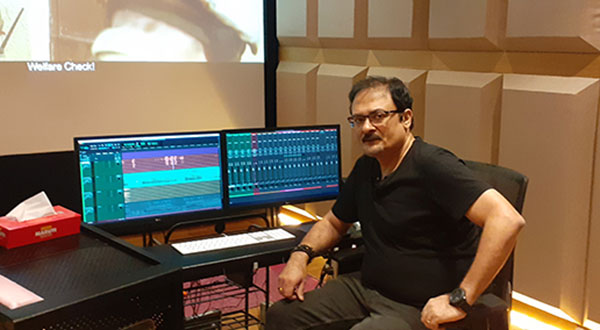
Having spent most of his career in Song and Music Recording, Bishwadeep Dipak Chatterjee was constantly toying with the idea of getting involved in designing sound for films. Thanks to his training at the Film and Television Institute of India (FTII), Pune, which prepares you for virtually every aspect of Sound Engineering and Recording, he could make this shift effortlessly. After recording and mixing the songs and the film score of Sanjay Bhansali’s film ‘Devdas’, Bishwadeep realized that the Music Industry, the world over, was going through a massive change. Bishwadeep spoke to the PT team in length about the transition to digital and his journey to “conceptualizing sound design in the box” at Qfactor, his newly done up Atmos-ready mix room
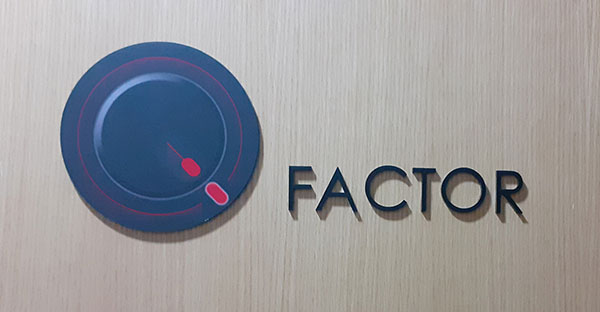
Ironically, the Music industry went into a kind of a recession two decades ago due to new developments in digital technology. “People began downloading free music instead of buying CDs off the shelf. Upgraded technology also meant musicians investing in state-of-the-art Digital Audio Workstations, VSTs, professional hardware like Speakers, microphones and mic-preamps at very affordable rates. This enabled composers, music producers and musicians to have their own music recording studios, the cost of which they could include in their package, effectively bringing down the recording time and budget of an average film song in large professional recording studios from about 10 days to hardly 1 or 2 days. Many large music studio facilities started folding up as the turn-over drastically dropped. As a Music recording engineer, I was involved with a song right from its conceptualization to the final mixed product, but in the current scenario, I wouldn’t have been exploited to my full potential. I took up Sound Designing for films not as an alternative, but because I wanted to extend my creative involvement in shaping the entire soundscape of the film. That doesn’t mean that I have abandoned music. I still record, mix and master music and songs for films, music albums, ad films and documentaries - not just in stereo but also in surround,” says Bishwadeep.
“The biggest challenge for me was to break out of the complacency of doing a job and starting out on my own. I had to think of something unique to present to the industry that would break the conventional system of working and bring in a more efficient and systematic approach to designing sound for films. I started off by discussing my approach and plans with the directors that I was mostly working with at that time, like Sanjay Bhansali, Rajkumar Hirani, Pradeep Sarkar etc. I wanted to take away the ‘burden’ of the humungous task of creating the soundscape for a film from their shoulders and wanted to present it to them before we went in for the final mixing of the film. “Sound Designing” for me isn’t just creating and laying sound effects, but treating the dialogues, the music and even the songs in a way that all these elements would harmoniously ‘fuse’ with one another, creating a unique overall aural experience complimenting the film. Now the director would be able to hear the soundscape of his film in its entirety and take most of the creative calls at this stage, creative calls like when to bring in the music, what kind of music, how the effects would sound, how the dialogues are treated etc., before we entered the mixing studio. They would end up feeling more confident about their sound and eventually the overall edit of the film.”
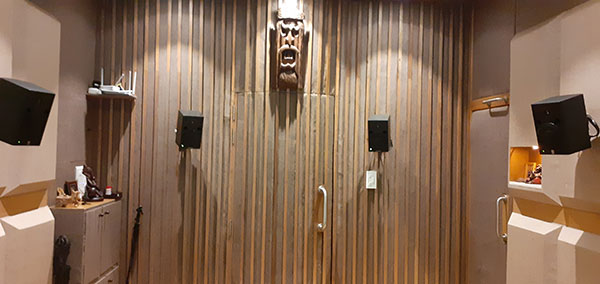
The entrance door on the back wall of Qfactor is curved - giving it a ‘semi-cylindrical’ shape. Double doors lined with magnets at the borders ensure that there are no gaps when the door closes.
The Sound Design Journey
Bishwadeep’s first offer to work as a Sound Designer came from the late Rituparno Ghosh, for his Bengali film “Chokher Bali” (2003) starring Aishwarya Rai. “The sound design work on this film was largely done in Kolkata, in a studio that I had designed. Then the majority of the sound post work, including the surround mixing was done in Ramanaidu Studios and Ramoji Film city. The main reason for doing it in Hyderabad was that none of the film mixing studios in Mumbai had Protools. The film mixing studios had barely switched from the 35mm magnetic tape format to the Hi-8 modular tape based digital format. I needed to mix on a non-linear platform as I did not want to be restricted to premixing all my dialogues, effects and music to just 24 tracks. I needed a Digital Audio Workstation (DAW).”
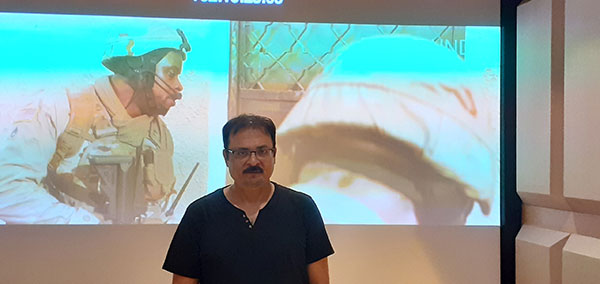
The cinematic professional screen behind Bishwadeep is tightly woven and has a minimum masking effect on the High frequencies.
Bishwadeep soon invested in a DAW called ‘Pyramix’ as he couldn’t afford to buy the Protools at that time and started working on a Hindi film by Rituparno Ghosh called ‘Raincoat’ (2004) starring Aishwarya Rai and Ajay Devgan. “I also invested in Pulz Speakers (which were modelled on the Tannoy dual - concentric speakers, for the front LCR and a Subwoofer. For the surrounds I invested in a pair of Yamaha MSP5’s – which also doubled up as my nearfield monitors for stereo mixes. I had a projector and a foldable screen on a stand. I intended this outfit to be a mobile unit so I could prop it up wherever the production team would set up their edit facilities. I soon realized that the concept of travelling with this unit was becoming too cumbersome. I had all the basic equipment by now but I didn’t have a place – all dressed up and nowhere to go! It was then that I decided to set up shop in my fairly long living room at home with some basic acoustic padding. I dare say that my living room was sounding much better than many studios that I have worked in. I would check my design and mixes in various mixing stages and was quite happy with the outcome. However, for music and song mixes, I would still have to depend on proper recording studios as the Pyramix was not compatible with most of the Protools DAWs in studios. The Pyramix had excellent sound quality and their own proprietory plug-ins that were seriously something to reckon with. But it was slow. The editing, file naming, etc were very sluggish and even though I had configured my PC as per their recommendations, there were constant issues between the PC and Pyramix which ate into my precious time. But I did carry the workstation along to wherever I mixed my films and it would play out really well. I don’t want to boast, but the interface was in my head and I knew that my little 5.1 living room facility was like a ‘Surround Nearfield’ monitoring system. Ofcourse, I had to tweak some for a bigger surround environment, but the mix was 90% there! Eventually I realized that I now had to move into a commercial space as I was beginning to stress out everyone at home.”
The Q Factor
Close to where he lived, in Andheri- Lokhandwala, Bishwadeep was lucky to find a place opposite Infiniti Mall, on the Link road in Andheri west. This area has now become the hub of the entertainment industry. “I moved in to a rented 250 square foot rectangular commercial office with a height of about 14 feet. I loved the height as I could hang my projector high and have a fairly large screen of about 7 feet by 5 feet. Having run out of funds, I did a make-shift padding up of the walls and the ceiling. A wall-to-wall carpet on the floor. This was heaven compared to what I had at home. My white picture screen was a Bombay Dyeing bedsheet, which had the perfect ‘audio transparency’ for the speakers that I would place behind the screen fabric. It was enough to arrest early reflections. That’s how my studio -Qfactor was born!
Shortly afterwards, I upgraded to the Protools and the Genelec 1037C’s with a matching Genelec Sub-woofer as my main monitors. I needed more ‘power’. I dedicated the Yamaha MSP5s to the surround and bought a new pair of the Genelec 8040 for my stereo mixes. Apart from Music, the 1037C was great at handling ‘transients’ and the dynamics of film mixes.”
Bishwadeep was also doing a lot of recording for ad-films and felt the need to come up with a recording studio around Bandra to mainly cater to advertising. “I met a budding actor and voice artist Abhishek Pandey through common friends and he too was working on the idea of a recording studio as he had space. We got together as partners and opened Orbis The Studio at Khar in 2007. Orbis has in the past also won an IRAA award for Best Recording Studio - Ad film.”
Meanwhile, Bishwadeep bought the unit housing Qfactor and decided to turn it into a small Atmos-ready mix room by properly designing the studio. “Continuous work in the studio was preventing me from executing the planned overhaul. After finishing work on Vinod Chopra’s ‘Shikara’ and Mohan Krishna Indraganti’s Telugu film ‘V’, the lockdown due to Covid was enforced. I utilized this time to work on my studio design. Shortly afterwards, a partial relaxation of the lockdown was announced and the labour force started returning to Mumbai from their respective home towns, I got busy executing the studio design work. Many offices in our building had permanently shut down due to the lockdown. I was probably an idiot who was building a studio with whatever funds I had left in my account, given the uncertainty that was to follow. But I had no choice…”
Qfactor started taking shape with a massive 11 feet X 4 feet bass-trap concealed in the ceiling above the screen. “I reinforced a side wall I share with the adjacent office, with a brick wall 3 inches from the outer wall. I then treated the whole room with a combination of high-density foam, rockwool and glass-wool. The wooden floor sits on a combination of rubber mats, rockwool and plywood isolated from the inner walls. Wood has a ‘spongy’ effect when compared to hard tiles or parquet flooring, which is ideal for good and uniform frequency response. The entrance door on the back wall is curved - giving it a ‘semi-cylindrical’ shape. Double doors lined with magnets at the borders ensure that there are no gaps when the door closes. Now there’s a professional screen in the front which is tightly woven and has a minimum masking effect on the High frequencies. I invested in an expensive Laser Viewsonic projector which gives a sharp and bright visual quality. 4K projection isn’t necessary for me, as we usually work with offline low resolution picture quality. I have wired for overhead speakers which I will eventually mount after upgrading my hardware.” Bishwadeep is now very happy with the end result because the room is sounding exactly like what he had wanted it to sound. “It is a very labour-intensive work beneath the fabric finish in terms of material used,” he adds.
At Qfactor Bishwadeep is running the Protools Ultimate on the old Mac pro tower, with the Omni interface among other things. “I will shortly be upgrading the computer to the new Mac Pro (Cheese grater), the MTRX Studio and the S1 controller. The MTRX studio will obviously provide the extra outs for my overhead speakers. Qfactor is now Atmos –ready! This reminds me, when I was working for the film Madras Café, Dolby came out with this wonderful new format at the time called Dolby Atmos. I wanted this new format for Madras Café since I thought that it would complement the subject big time! I hung two speakers from the ceiling to get the feel of a chopper flying overhead in the theater and needless to say, it was a very exciting experience. Madras Café became the first Indian film to be mixed in Native Atmos. It also gave me my first National Award as a Sound Designer. Since then, all the films that I worked on were in the Dolby Atmos format.” Bishwadeep’s current projects in Atmos include Karan Johar’s Brahmastra and Attack by John Abraham.
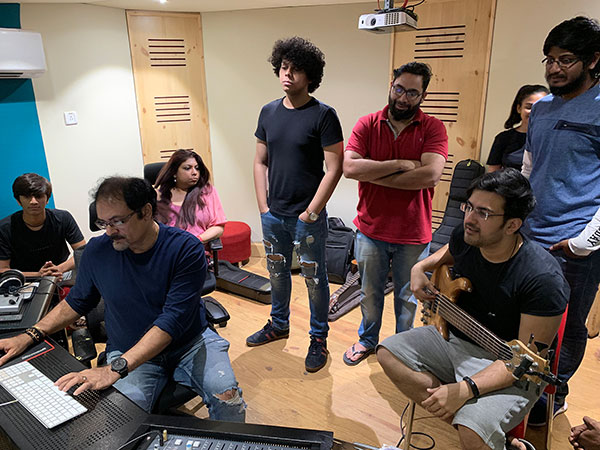
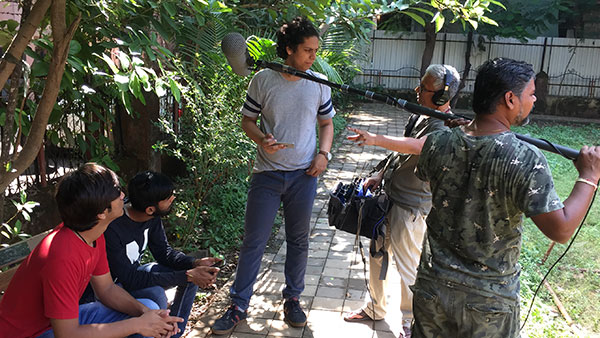
Students at the Timbreworx Advanced Film Audiography Institute (TAFA) with faculty members Bishwadeep Chatterjee (top) and Nihar Ranjan Samal (below)
To give the PT team a feel of the new suite, Bishwadeep played a small sequence from a film that he had worked on called Chintu Ka Birthday directed by Satyanshu and Devanshu, which is about an Indian family stuck in Baghdad, when the Gulf War breaks out, with Vinay Pathak playing the protagonist’s role.
Audio post production is arduous and time-consuming (and also monotonous to the unimaginative) but not so for Bishwadeep. The film was shot in an indoor set in Mumbai and Bishwadeep was tasked with having to create Baghdad from his studio. The time and effort that had gone into the seemingly small and minor details like bomb explosions and gun shots and the reference he had taken from the earlier CNN coverages of the first Iraq war was evident. The sound actually surrounded us in the true sense and added a potent layer of significance to what we were watching on screen.
“I had to create Iraq here in this room of mine. It’s a very time-consuming job. There are hundreds of tracks that you are working on and I also had to be careful to not overdo the whole war sequence so that it does not interfere with the drama,” he explained.
TAFA Times Ahead...
“Encouraged with the success of my little sound design/mixing room, I, along with my partner and ace Production Sound Mixer and Sound Designer – Nihar Ranjan Samal, opened another two such studios to handle the workload between our projects. We call our company Timbreworx India. “
Both Nihar and Bishwadeep were being invited to FTII (Pune), SRFTI (Kolkata) and several private institutions to hold workshops, masterclasses, seminars and presentations on Sound Design and Production Sound in cinema. Many of these institutions would request them for internships for their students. It was then that they decided to open an institute of their own that would focus on imparting specialized training in Film Audiography and thus the Timbreworx Advanced Film Audiography Institute or TAFA was born. “There are many institutes providing training in Music Production and Recording, but apart from FTII and SRFTI, there were hardly any places that would provide training on location recording, film post production and Music recording. Our studios become classrooms early mornings from 8.00 am to 11.00 am, 6 days a week. We believe in backing up theory with intense practical training. We have our music recording practicals at Orbis. We have been recording songs with singers, composers and musicians from the industry. I have designed this concept in such a way that both the students and independent artists benefit mutually. Aesthetics and sensibilities go hand in hand with practicals. Our footfalls are gradual as we don’t want to bite off more than we can chew, but we are getting there. Unfortunately, the second wave of Covid is preventing us from admitting the next batch of very eager students, but we are hoping that normalization comes soon.
Being practicing professionals in the film industry, both Nihar and I treat our students as potential professionals of the future. When students are joining us, they are not joining an institute – but they are directly joining the industry! Hence our motto- Professionals for Professionals!” he concludes.